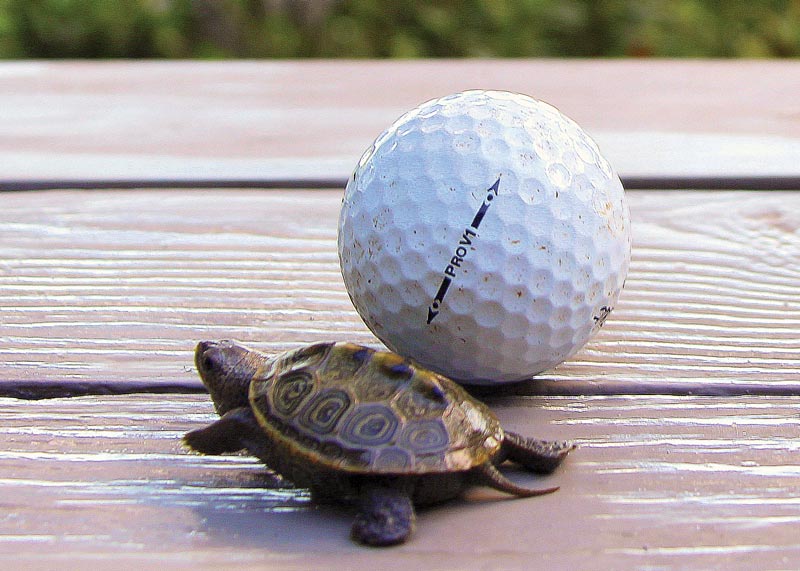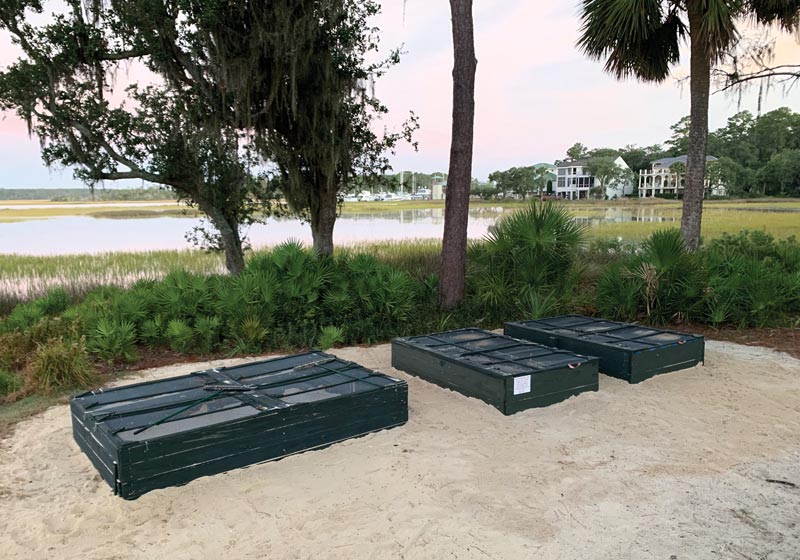
Just one of the 20,000 or so diamondback terrapin hatchlings rescued from the bunkers at The Landings Club near Savannah, Ga. Photo by Carolyn McInerney
There’s nothing quite like an adorable little turtle to help fight green fatigue.
The environmental message surrounding golf courses is nothing if not consistent, stressing everything from the benefits of green space to water quality management. But who could blame a layperson if, after a bit of talk about groundwater filtration or carbon sequestration, the eyes started to glaze a bit?
“One of the best parts of this is, we all know golf courses do things with the environment, but it’s hard for people to really latch on to some of those stories,” says Chris Steigelman, CGCS, director of golf maintenance for the south courses of The Landings Club on Skidaway Island, Ga., outside Savannah. “You can only tell people so many times that you’re saving water or saving fertilizer. With a story like this ... it’s neat to be a part of something like this, where you get a chance to really engage with the community.”
The Skidaway Audubon Diamondback Terrapin Rescue Project has grown from one intrigued club member rescuing a handful of eggs to a massive terrapin hatchery billed as the largest on the East Coast. And make no mistake: It’s kind of a big deal. Since its beginnings in 2002, the project has helped hatch upward of 20,000 diamondback terrapins, one carefully transplanted bunker nest at a time.
A diamondback terrapin lays its eggs in a bunker on the Palmetto Course of The Landings Club in May 2019:
“It’s gotten bigger and bigger and bigger,” says Steigelman, a 16-year GCSAA member. “It’s a wonderful program.”
It all started with a chance encounter.
In 2002, Carolyn McInerney moved into a home off the No. 3 hole of The Landings Club’s Plantation Course. One afternoon, she saw four men on the green, and her attention was drawn to a turtle that — unconcerned with the foursome — had crawled out of the nearby marsh, across the green, and dropped into a bunker. The intrepid terp laid her eggs, then crawled back the way she had come, through a different foursome putting out, and dropped back into the marsh.
Talk about (p)laying through.
“The next morning,” McInerney says, “I looked, and the nest was totally destroyed. I thought, ‘This isn’t fair.’”
The nest had been excavated by a predator, the terrapin eggs likely becoming breakfast for a fox or raccoon. Such predation plays a huge role in the abysmal hatchling survival rate among diamondback terrapins, pegged in the range of 1% to 3%. McInerney knew none of that. She simply knew she wanted to help the terps.
Whenever she saw a mother terrapin laying eggs, she would transplant them into sand-filled flowerpots. After 60 to 90 days, babies would hatch, and McInerney would shepherd them to the marsh.
“It became a passion of mine,” she recalls. “I didn’t know I was probably breaking the law.”
According to the U.S. Fish and Wildlife Service, the diamondback terrapin is the only turtle in the U.S. that lives exclusively in brackish saltwater marshes, bays and lagoons, from Cape Cod, Mass., to Corpus Christi, Texas. The diamondback terrapin was the signature ingredient in a soup that was a popular delicacy in the late 19th century. Harvest and export decimated the population, but prohibition — sherry was another main ingredient for the stew — and the Great Depression depressed demand.
Though the population has rebounded, the diamondback terrapin is listed as “vulnerable” by the International Union for Conservation of Nature. In Georgia, it was listed as a “species of concern” in 2003.

Nest boxes for hatching terrapin eggs in an out-of-play area at The Landings Club. Photo by Chris Steigelman
With help from naturalist John Crawford of the University of Georgia Marine Education Center and Aquarium, McInerney ran the Skidaway rescue project for six years.
“My last season (by herself), I had 90 flowerpots on my porch,” she recalls. “My husband was ready to divorce me.”
The Landings Club adopted the program in 2010 as part of its recertification with Audubon International. Now, seven volunteers patrol Plantation twice a day, every day, for 2½-hour stretches spanning high tide during the April to August nesting season. If they witness a laying, they’ll mark the nest, dig up the eggs, and then transplant the eggs into one of six nest boxes located in out-of-play areas on the course. The turtles favor a handful of holes on Plantation, though occasionally they’ll lay on another of the club’s six courses. Volunteers patrol only Plantation. Golfers and maintenance workers provide additional vigilance.
A volunteer removes diamondback terrapin eggs from a bunker at The Landings Club, to be relocated to a protected hatchery:
“Golfers and the golf course maintenance people are phenomenal,” McInerney says.
Since she began keeping track in 2010, the program has rescued more than 17,000 eggs and released 15,000 terrapins. McInerney guesses the rescue total is closer to 20,000.
Crucial to the program are its release parties. All Skidaway Islanders are invited to a nearby park, where youngsters can handle and name a 1-inch hatchling. There are educational presentations and a race to see which terrapin makes it to the marsh first. In 2019, there were six release parties, with anywhere from 73 to 117 participants.
“The kids love it,” McInerney says. “The kids, the parents ... everybody loves the turtles. The joke is, we’re going to have so many, the golfers are going to be tripping on turtles.”
Steigelman, who has been at The Landings Club since 2004, suggests they probably wouldn’t mind.
“Our golfers are appreciative,” he says. “They love seeing the impact we’re having.”
Andrew Hartsock is GCM’s managing editor.